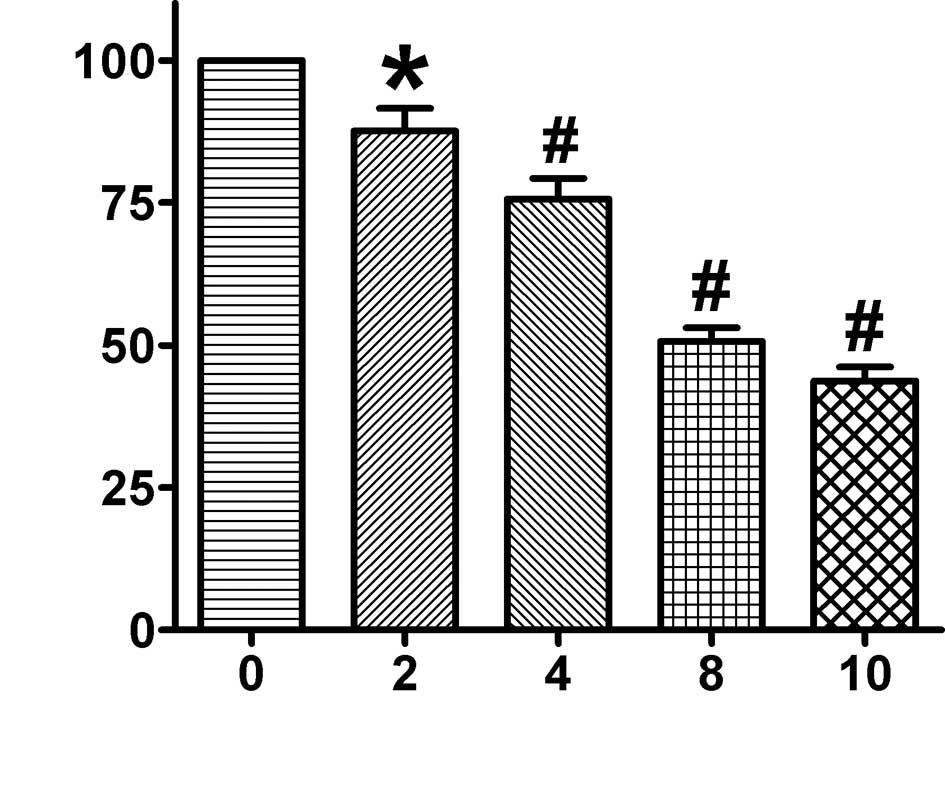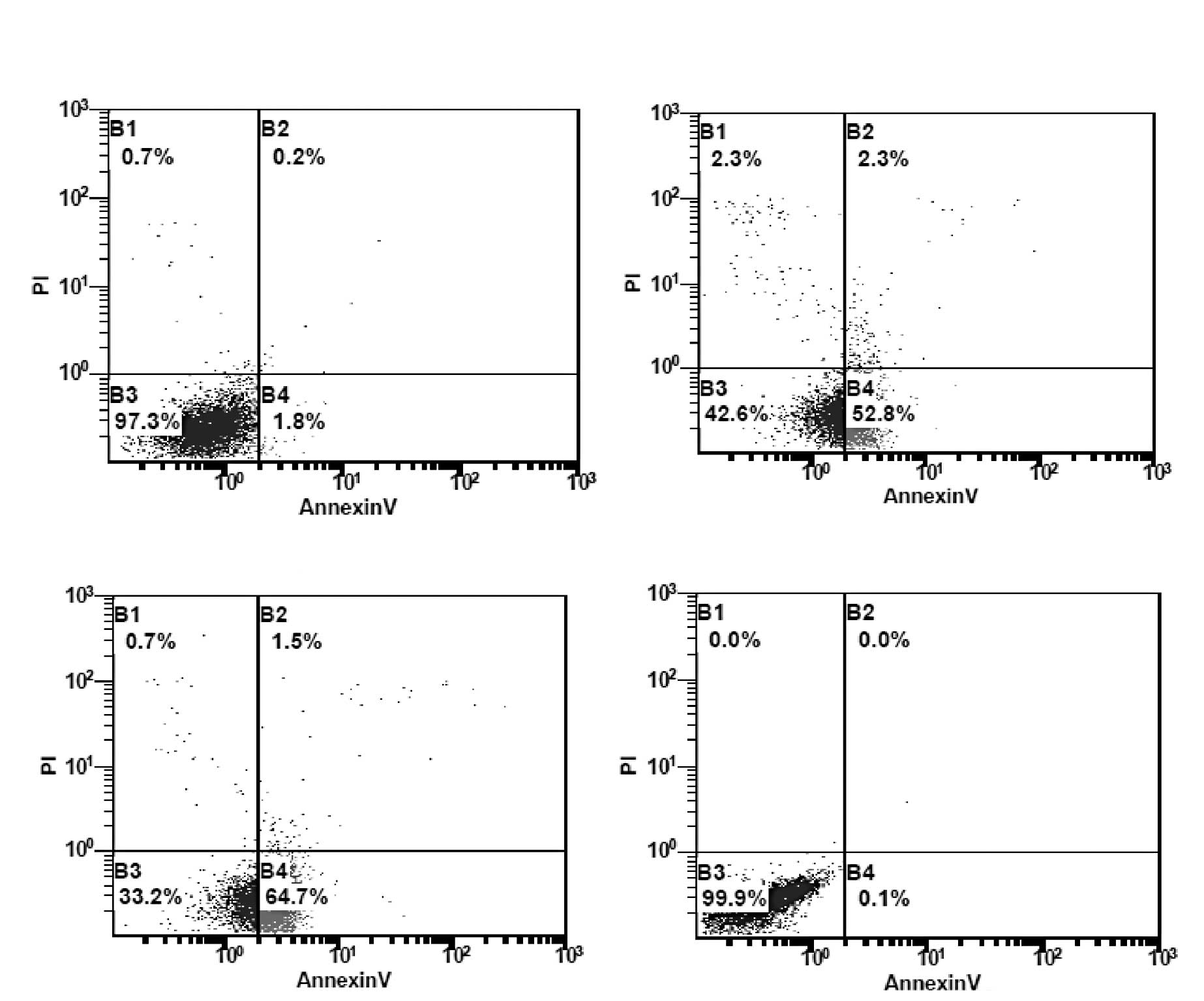|
1.
|
Sledge GW Jr: Breast cancer as a world
challenge. Clin Breast Cancer. 5:112004. View Article : Google Scholar : PubMed/NCBI
|
|
2.
|
Bange J, Zwick E and Ullrich A: Molecular
targets for breast cancer therapy and prevention. Nat Med.
7:548–552. 2001. View
Article : Google Scholar : PubMed/NCBI
|
|
3.
|
Vernhet L, Allain N, Le Vee M, Morel F,
Guillouzo A and Fardel O: Blockage of multidrug
resistance-associated proteins potentiates the inhibitory effects
of arsenic trioxide on CYP1A1 induction by polycyclic aromatic
hydrocarbons. J Pharmacol Exp Ther. 304:145–155. 2003. View Article : Google Scholar
|
|
4.
|
Cyranoski D: Arsenic patent keeps drug for
rare cancer out of reach of many. Nat Med. 13:10052007. View Article : Google Scholar : PubMed/NCBI
|
|
5.
|
Sun HD, Ma L, Hu XC and Zhang TD: Ai-Lin I
treated 32 cases of acute promyelocytic leukemia. Chin J Integr
Chin West Med. 12:170–171. 1992.
|
|
6.
|
Woo SH, Park IC, Park MJ, et al: Arsenic
trioxide induces apoptosis through a reactive oxygen
species-dependent pathway and loss of mitochondrial membrane
potential in HeLa cells. Int J Oncol. 21:57–63. 2002.
|
|
7.
|
Zhang TC, Cao EH, Li JF, Ma W and Qin JF:
Induction of apoptosis and inhibition of human gastric cancer MG803
cell growth by arsenic trioxide. Eur J Cancer. 35:1258–1263. 1999.
View Article : Google Scholar : PubMed/NCBI
|
|
8.
|
Shen ZY, Shen J, Cai WJ, Hong C and Zheng
MH: The alteration of mitochondria is an early event of arsenic
trioxide-induced apoptosis in esophageal carcinoma cells. Int J Mol
Med. 5:155–158. 2000.PubMed/NCBI
|
|
9.
|
Akao Y, Nakagawa Y and Akiyama K: Arsenic
trioxide induces apoptosis in neuroblastoma cell lines through the
activation of caspase 3 in vitro. FEBS Lett. 455:59–62.
1999. View Article : Google Scholar : PubMed/NCBI
|
|
10.
|
Uslu R, Sanli UA, Sezgin C, et al: Arsenic
trioxide-mediated cytotoxicity and apoptosis in prostate and
ovarian carcinoma cell lines. Clin Cancer Res. 6:4957–4964.
2000.PubMed/NCBI
|
|
11.
|
Chow SK, Chan JY and Fung KP: Inhibition
of cell proliferation and the action mechanisms of arsenic trioxide
As2O3 on human breast cancer cells. J Cell
Biochem. 93:173–187. 2004. View Article : Google Scholar : PubMed/NCBI
|
|
12.
|
Ye J, Li A, Liu Q, Wang X and Zhou J:
Inhibition of mitogen-activated protein kinase kinase enhances
apoptosis induced by arsenic trioxide in human breast cancer MCF-7
cells. Clin Exp Pharmacol Physiol. 32:1042–1048. 2005. View Article : Google Scholar
|
|
13.
|
Wang H, Zhang Y, Cao L, et al: HERG
K+ channel, a regulator of tumor cell apoptosis and
proliferation. Cancer Res. 62:4843–4848. 2002.PubMed/NCBI
|
|
14.
|
Sun HL, Chu WF, Dong DL, et al:
Choline-modulated arsenic trioxide-induced prolongation of cardiac
repolarization in Guinea pig. Basic Clin Pharmacol Toxicol.
98:381–388. 2006. View Article : Google Scholar : PubMed/NCBI
|
|
15.
|
Ficker E, Kuryshev YA, Dennis AT, et al:
Mechanisms of arsenic-induced prolongation of cardiac
repolarization. Mol Pharmacol. 66:33–44. 2004. View Article : Google Scholar : PubMed/NCBI
|
|
16.
|
Vandenberg JI, Walker BD and Campbell TJ:
HERG K+ channels: friend and foe. Trends Pharmacol Sci.
22:240–246. 2001.
|
|
17.
|
Bianchi L, Wible B, Arcangeli A, et al:
herg encodes a K+ current highly conserved in tumors of
different histogenesis: a selective advantage for cancer cells?
Cancer Res. 58:815–822. 1998.
|
|
18.
|
Cherubini A, Taddei GL, Crociani O, et al:
HERG potassium channels are more frequently expressed in human
endometrial cancer as compared to non-cancerous endometrium. Br J
Cancer. 83:1722–1729. 2000. View Article : Google Scholar
|
|
19.
|
Meyer R and Heinemann SH: Characterization
of an eag-like potassium channel in human neuroblastoma cells. J
Physiol. 508:49–56. 1998. View Article : Google Scholar : PubMed/NCBI
|
|
20.
|
Shao XD, Wu KC, Hao ZM, Hong L, Zhang J
and Fan DM: The potent inhibitory effects of cisapride, a specific
blocker for human ether-a-go-go-related gene (HERG) channel, on
gastric cancer cells. Cancer Biol Ther. 4:295–301. 2005. View Article : Google Scholar
|
|
21.
|
Wang L, Feng ZP, Kondo CS, Sheldon RS and
Duff HJ: Developmental changes in the delayed rectifier
K+channels in mouse heart. Circ Res. 79:79–85. 1996.
View Article : Google Scholar : PubMed/NCBI
|
|
22.
|
Wang L and Duff HJ: Identification and
characteristics of delayed rectifier K+ current in fetal
mouse ventricular myocytes. Am J Physiol. 270:H2088–H2093.
1996.PubMed/NCBI
|
|
23.
|
Liu P and Han ZC: Treatment of acute
promyelocytic leukemia and other hematologic malignancies with
arsenic trioxide: review of clinical and basic studies. Int J
Hematol. 78:32–39. 2003. View Article : Google Scholar : PubMed/NCBI
|
|
24.
|
Han H, Long H, Wang H, Wang J, Zhang Y and
Wang Z: Progressive apoptotic cell death triggered by transient
oxidative insult in H9c2 rat ventricular cells: a novel pattern of
apoptosis and the mechanisms. Am J Physiol Heart Circ Physiol.
286:H2169–H2182. 2004. View Article : Google Scholar
|
|
25.
|
Roy S: Caspase at the heart of the
apoptotic cell death pathway. Chem Res Toxicol. 13:961–962. 2000.
View Article : Google Scholar : PubMed/NCBI
|
|
26.
|
Li X, Ding X and Adrian TE: Arsenic
trioxide causes redistribution of cell cycle, caspase activation,
and GADD expression in human colonic, breast, and pancreatic cancer
cells. Cancer Invest. 22:389–400. 2004. View Article : Google Scholar
|
|
27.
|
Crociani O, Guasti L, Balzi M, et al: Cell
cycle-dependent expression of HERG1 and HERG1B isoforms in tumor
cells. J Biol Chem. 278:2947–2955. 2003. View Article : Google Scholar : PubMed/NCBI
|
|
28.
|
Guasti L, Crociani O, Redaelli E, et al:
Identification of a post-translational mechanism for the regulation
of hERG1 K+ channel expression and hERG1 current density
in tumor cells. Mol Cell Biol. 28:5043–5060. 2008. View Article : Google Scholar : PubMed/NCBI
|
|
29.
|
Arcangeli A: Expression and role of hERG
channels in cancer cells. Novartis Found Symp. 266:225–232. 2005.
View Article : Google Scholar : PubMed/NCBI
|
|
30.
|
Li H, Liu L, Guo L, et al: HERG
K+ channel expression in
CD34+/CD38−/CD123 (high) cells and primary
leukemia cells and analysis of its regulation in leukemia cells.
Int J Hematol. 87:387–392. 2008.
|
|
31.
|
Afrasiabi E, Hietamäki M, Viitanen T,
Sukumaran P, Bergelin N and Törnquist K: Expression and
significance of HERG (KCNH2) potassium channels in the regulation
of MDA-MB-435S melanoma cell proliferation and migration. Cell
Signal. 22:57–64. 2010. View Article : Google Scholar : PubMed/NCBI
|
|
32.
|
Zhao J, Wei XL, Jia YS and Zheng JQ:
Silencing of herg gene by shRNA inhibits SH-SY5Y cell growth in
vitro and in vivo. Eur J Pharmacol. 579:50–57. 2008. View Article : Google Scholar : PubMed/NCBI
|
|
33.
|
Cherubini A, Hofmann G, Pillozzi S, Guasti
L, Crociani O, Cilia E, et al: Human ether-a-go-go-related gene 1
channels are physically linked to beta1 integrins and modulate
adhesion-dependent signaling. Mol Biol Cell. 16:2972–2983. 2005.
View Article : Google Scholar : PubMed/NCBI
|
|
34.
|
Bauer CK, Wulfsen I, Schafer R, Glassmeier
G, Wimmers S and Flitsch J: HERG K(+) currents in human
prolactin-secreting adenoma cells. Pflugers Arch. 445:589–600.
2003.
|
|
35.
|
Gullo F, Ales E, Rosati B, et al: ERG
K+ channel blockade enhances firing and epinephrine
secretion in rat chromaffin cells: the missing link to LQT2-related
sudden death? FASEB J. 17:330–332. 2003.PubMed/NCBI
|
|
36.
|
Rosati B, Marchetti P, Crociani O, et al:
Glucose- and arginine-induced insulin secretion by human pancreatic
beta-cells: the role of HERG K(+) channels in firing and release.
FASEB J. 14:2601–2610. 2000.PubMed/NCBI
|
|
37.
|
Shao XD, Wu KC, Guo XZ, Xie MJ, Zhang J
and Fan DM: Expression and significance of HERG protein in gastric
cancer. Cancer Biol Ther. 7:45–50. 2008. View Article : Google Scholar : PubMed/NCBI
|
|
38.
|
Lastraioli E, Guasti L, Crociani O, et al:
herg1 gene and HERG1 protein are overexpressed in colorectal
cancers and regulate cell invasion of tumor cells. Cancer Res.
64:606–611. 2004. View Article : Google Scholar : PubMed/NCBI
|
|
39.
|
Masi A, Becchetti A, Restano-Cassulini R,
et al: hERG1 channels are overexpressed in glioblastoma multiforme
and modulate VEGF secretion in glioblastoma cell lines. Br J
Cancer. 93:781–792. 2005. View Article : Google Scholar : PubMed/NCBI
|















